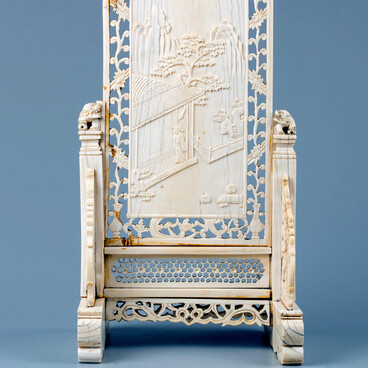The Samara Regional Art Museum houses a number of artifacts made in the shippo or cloisonné technique. “Shippo” (from Japanese meaning “seven treasures”) is a technique for decorating enameled metal objects with complex patterns. This technique is known all around the world as cloisonné (from the French “cloison” — a partition). Enamels came to Japan in the 6th — 7th century through China and Korea and flourished in Japan in the 17th century. At that time, the technique was commonly used to decorate Japanese swords.
The vase “Dragons and Phoenixes” is stunning and peculiar: the subtlety with which the artist worked out the patterns and details amazes the viewer. Above the images of mythical creatures, we can see a variety of flowers, plants and other symbols of Japanese culture. The dragon is often mentioned in Japanese folklore and mythology. Japanese dragons have three claws on each paw, which distinguishes them from other dragons from eastern mythology. The Japanese dragon, in response to one’s reverence and respect, could thank its admirer with a treasure, as it was believed that dragons were very rich. The phoenix symbolizes the sun, bluntness, loyalty, justice and obedience. Phoenix is called “hoo” in Japanese, which literally means “immortal bird”.
When working in the technique of cloisonné enamel, a wire or metal strips are soldered onto the metal surface and the formed cells are filled with glass-paste — an enamel. After firing, the surface is smoothly polished, so that the metal and enamel can form a flat plane, while the metal partitions create a specific pattern. This enameling method was especially common in Japan. The metal base is usually gold, less often silver or copper. First, a glaze is applied to it and then it is painted, after which the surface is covered with a colorless transparent enamel with glaze.
The development of Japanese cloisonné production is attributed to a former samurai Kaji Tsunekichi (1803 — 1883) from Nagoya. It is believed that around 1838 the samurai got hold of a Chinese cloisonné enamel object for the first time. Kaji Tsunekichi broke it, meticulously studied the composition and created a small cloisonné plate himself. The highest level of cloisonné of the Meiji era (1868 — 1912) remains unattainable up to present day.
The vase “Dragons and Phoenixes” is stunning and peculiar: the subtlety with which the artist worked out the patterns and details amazes the viewer. Above the images of mythical creatures, we can see a variety of flowers, plants and other symbols of Japanese culture. The dragon is often mentioned in Japanese folklore and mythology. Japanese dragons have three claws on each paw, which distinguishes them from other dragons from eastern mythology. The Japanese dragon, in response to one’s reverence and respect, could thank its admirer with a treasure, as it was believed that dragons were very rich. The phoenix symbolizes the sun, bluntness, loyalty, justice and obedience. Phoenix is called “hoo” in Japanese, which literally means “immortal bird”.
When working in the technique of cloisonné enamel, a wire or metal strips are soldered onto the metal surface and the formed cells are filled with glass-paste — an enamel. After firing, the surface is smoothly polished, so that the metal and enamel can form a flat plane, while the metal partitions create a specific pattern. This enameling method was especially common in Japan. The metal base is usually gold, less often silver or copper. First, a glaze is applied to it and then it is painted, after which the surface is covered with a colorless transparent enamel with glaze.
The development of Japanese cloisonné production is attributed to a former samurai Kaji Tsunekichi (1803 — 1883) from Nagoya. It is believed that around 1838 the samurai got hold of a Chinese cloisonné enamel object for the first time. Kaji Tsunekichi broke it, meticulously studied the composition and created a small cloisonné plate himself. The highest level of cloisonné of the Meiji era (1868 — 1912) remains unattainable up to present day.





